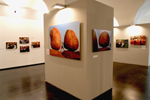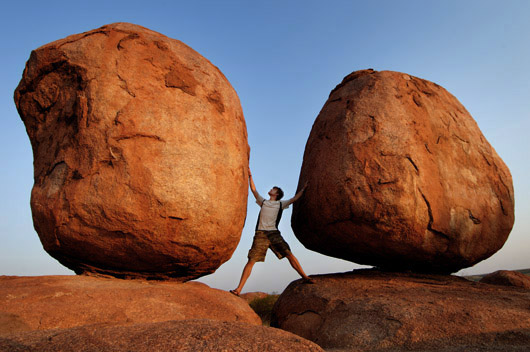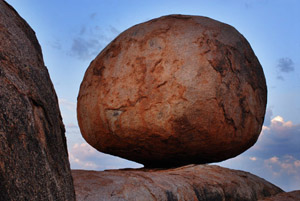Australia,
sulle tracce di Chatwin venti anni dopo Le Vie dei Canti
Palazzo Ducale, Genova
Australia, in Chatwin's footsteps twenty years
after The Songlines
Palazzo Ducale, Genoa


L’appuntamento
è al tramonto. Quando le rocce si accendono. Arrivano grandi bus
che scaricano a centinaia turisti per qualche ora, carovane di jeep superattrezzate
che sostano per la notte attorno alle aree di barbecue, come i piccoli
camper e pulmini con materassi dentro adattati da giovani europei o americani
che attraversano il continente. È un’apoteosi di Australian
Tours, Desert Adventure, binocoli, brindisi al sole che se ne va, pose
per foto ricordo romantiche, strambe, atletiche. Vengono a vedere una
delle più singolari attrazioni naturali d’Australia: le Devils
Marbles, le “palle dei diavoli” o Karlu Karlu come le chiamano
i Warumungu, l’etnia locale. Massi a migliaia sparsi per la valle,
una piccola isola di granito formatasi più di un miliardo e mezzo
di anni fa in mezzo a un oceano di arenaria, frantumatasi in blocchi dalle
forme più bizzarre, erosi da acqua e vento, al punto che molti,
quasi perfettamente sferici, si innalzano in equilibrio apparentemente
impossibile. Da alcuni studiosi le Devils Marbles sono considerate tra
i più antichi siti religiosi al mondo. Le guide (e gli stessi pannelli
della riserva che le protegge) dicono che rappresentino le uova del Serpente
Arcobaleno. Ma per i proprietari tradizionali del luogo sono i resti di
una cintura di capelli tessuta dagli antenati creatori durante il loro
passaggio nella valle. Nel 1953 una delle marble è stata rimossa
e portata ad Alice Springs per il memoriale di John Flynn, il fondatore
del Royal Flying Doctor Service. Nel 1999, dopo una controversia lunga
quarantacinque anni, le associazioni aborigene sono riuscite a farla rimuovere
dalla tomba, ripulirla e riportarla al suo posto: la si riconosce subito,
un po’ più bianca, ma di nuovo fra le rocce sorelle
